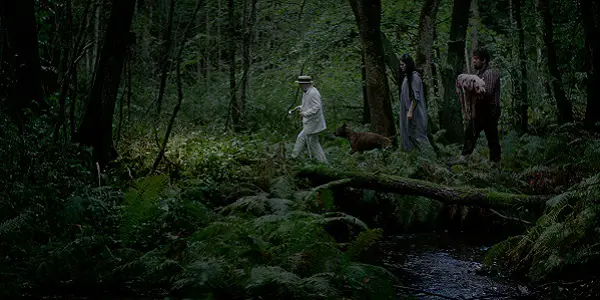KOKO-DI KOKO-DA: A Nightmarish Vision Of Grief

Lee Jutton has directed short films starring a killer toaster,…
The twisted terror that can live on at the heart of one’s grief, especially when that grief is over the death of a child, has been the subject of cinematic exploration for many decades. From Donald Sutherland imagining his drowned daughter stalking him on the streets of Venice in Nicholas Roeg’s Don’t Look Now, to Charlotte Rampling violently unraveling in Lars Von Trier’s Antichrist, to Toni Collette being overcome by the occult in Ari Aster’s Hereditary, many filmmakers have combined aspects of psychological and supernatural horror to examine how the grief and the guilt that results from losing a child can continue to haunt us.
The latest addition to this strange and sad canon is Swedish filmmaker Johannes Nyholm’s Koko-di Koko-da, in which a grieving couple attempt to revive their crumbling marriage on a camping trip and instead find themselves trapped in an endless cycle of nightmarish events. Yet despite this film’s boundless originality, especially when it comes to crafting terrifying images, one is left with more of a sense of respect for what was attempted in Koko-di Koko-da than of enjoyment of what resulted.
Into the Woods
The film takes its title from the delightfully creepy song emitted by a music box purchased for Maja (Katarina Jakobson) for her eighth birthday. Maja and her parents, Tobias (Leif Edlund) and Elin (Ylva Gallon), are visiting Denmark from their native Sweden to celebrate the occasion, but what begins as a lovely portrait of familial happiness quickly devolves into tragedy when Elin is taken to the hospital with a case of shellfish poisoning. The next morning, one member of the trio has passed away in the night – but it isn’t Elin.
Three years after the shock of losing their daughter, Tobias and Elin decide to finally go on another vacation, this time a rustic camping trip. Immediately, one can see that their marriage is suffering; both are still wrestling with feelings of guilt over Maja’s death and have very little patience or understanding for each other and their needs and desires. Frustrated with Elin’s nonstop complaining about the trip, Tobias abruptly decides that they’ll go off-road and camp in the first clearing they find, much to the dismay of his wife.

The night seems to pass uneventfully until the crack of dawn when Elin emergers from the tent to go to the bathroom. It is then that she is accosted by three horrifying figures who emerge from the woods: an older man in a white suit (Peter Belli), a girl with dark pigtails that stream down her shoulders and a Staffordshire Bull Terrier on a leash (Brandy Litmanen), and a hulking man with curly hair who is carrying another dog, this one dead (Morad Baloo Khatchadorian). There isn’t any random band of eccentric characters; they are the figures painted on the side of the music box purchased for Maja on that fateful trip to Denmark.
The trio proceeds to physically and emotionally abuse Elin before setting the live dog loose inside the tent with Tobias so that it will maul him to death. The entire sequence is stomach-turning courtesy of Belli, who renders the cheerful, singsong man in the white suit one of the more terrifying movie villains in recent memory; when he is on screen, evil seems to ooze from every frame. The glee he takes from Elin’s wracking sobs and Tobias’ screams of pain make it hard to continue watching these scenes without feeling sick.
Alas, Tobias, and Elin’s torture is not over with their apparent demise; instead, we find them immediately back in their car, engaging in yet another argument as they drive down the twilight road to inevitably pull into the same clearing for the night. That’s right: Tobias and Elin are trapped in the most twisted version of Groundhog Day that one could possibly imagine, and until they can overcome their grief and their guilt – not to mention their loathing for each other – they’ll never escape.
Wake Up
Over and over again, the trio led by the man in the white suit is heralded by the sight of a mysterious white cat, luminous amidst the dark trees. They appear and torture Elin and Tobias in a variety of different ways, usually culminating in being mauled by the dog before the couple is forced to start all over again. Each time, Tobias grows increasingly agitated when he wakes in the morning, with some faint memory of what happened during the previous cycle lurking in the back of his mind. He tries various ways of saving himself and Elin from the nightmare that awaits, but no matter what he does, the violence rained down upon him and Elin seems inevitable. And each time, it becomes harder and harder, as an audience member, to sit and watch. Koko-di Koko-da is under 90 minutes long, but it feels more like three hours.

The film is impeccably designed and shot, with the nightmare world of the clearing rendered all too real in the watery light of early morning. The aesthetic of the trio of music box characters is perfectly chilling, combining elements of stereotypical nursery rhyme characters with a healthy dose of rot. In another interesting visual choice, the many scenes of chilling brutality are offset by some poetic shadow-puppet sequences that portray Tobias and Elin’s grief, and their struggle to overcome it and move on, through a cast of animal characters, including a family of rabbits. Needless to say, these are much easier and more enjoyable to watch than the scenes featuring the man in the white suit cackling as he urges his vicious dog to lick Elin’s crotch.
Have you ever watched a movie in which you appreciated the artistic impetus behind it but didn’t truly care for the final product? That is how I felt about Koko-di Koko-da. Nyholm’s depiction of grief as a nightmare that is almost impossible to wake from, and the ways that can destroy what was once a healthy relationship, is admirable in its unique brand of freakiness, and many of the images in the film continue to haunt me since I first watched it. But for me, the film felt as sadistic as the man in the white suit himself, with little of the emotional catharsis that one hopes for in horror of this nature.
Conclusion
A good horror film isn’t easy to watch, but it should leave you with some feeling of satisfaction by the time the end credits roll. I think of Don’t Look Now and the thrilling realization that Sutherland’s character had foreseen his own death, or Hereditary and the dark familial legacy that was revealed in its closing moments, and I feel a strange sense of elation. But with Koko-di Koko-da, I only feel empty.
What do you think? What are some of the most potent cinematic depictions of grief? Share your thoughts in the comments below.
Koko-di Koko-da is screening in virtual cinemas in the U.S. starting November 6, 2020. It will be available on demand in the U.S. beginning December 8, 2020. You can find more international release dates here.
Watch Koko-di Koko-da
Does content like this matter to you?
Become a Member and support film journalism. Unlock access to all of Film Inquiry`s great articles. Join a community of like-minded readers who are passionate about cinema - get access to our private members Network, give back to independent filmmakers, and more.
Lee Jutton has directed short films starring a killer toaster, a killer Christmas tree, and a not-killer leopard. Her writing has appeared in publications such as Film School Rejects, Bitch: A Feminist Response to Pop Culture, Bitch Flicks, TV Fanatic, and Just Press Play. When not watching, making, or writing about films, she can usually be found on Twitter obsessing over soccer, BTS, and her cat.













